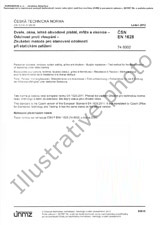We need your consent to use the individual data so that you can see information about your interests, among other things. Click "OK" to give your consent.
ČSN EN 17323 (806122)
Geosynthetics - Determination of tensile properties of Polymeric Geosynthetic Barriers
Translate name
STANDARD published on 1.1.2021
The information about the standard:
Designation standards: ČSN EN 17323
Classification mark: 806122
Catalog number: 511077
Publication date standards: 1.1.2021
SKU: NS-1012617
The number of pages: 24
Approximate weight : 72 g (0.16 lbs)
Country: Czech technical standard
Category: Technical standards ČSN
The category - similar standards:
Annotation of standard text ČSN EN 17323 (806122):
This document specifies test methods for the determination of tensile properties of polymeric geosynthetic barriers PE (e.g. PE-HD and PE-LLD), FPO (e.g. EVA, FPP, and PE-VLD), PVC-P and EPDM.
Method A is suitable for testing polymeric geosynthetic barriers (GBR-P), made of PVC-P, EPDM and FPO (e.g. EVA, FPP and PE-VLD), non-reinforced (including maximum 80 g/m2 glass fleece) and without backing.
Method B is suitable for testing polymeric geosynthetic barriers (GBR-P) made of PE (e.g. PE-HD and PE-LLD), non-reinforced and without backing.
Method C is suitable for testing polymeric geosynthetic barriers (GBR-P), reinforced and/or with backing.
Method D is suitable for measuring modulus (if required) of all non-reinforced GBR-P.
NOTE For homogenous polymers not listed above, method A and D can be used
Preview of the standard ČSN EN 17323 (806122)
We recommend:
Technical standards updating
Do you want to make sure you use only the valid technical standards?
We can offer you a solution which will provide you a monthly overview concerning the updating of standards which you use.
Would you like to know more? Look at this page.




 Cookies
Cookies
